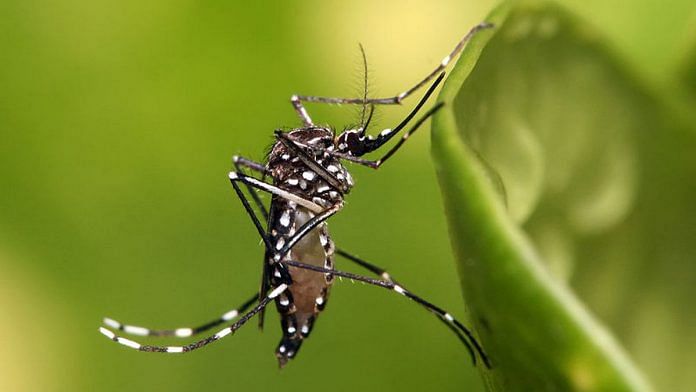Bengaluru: Between 2013 and 2015, in a field experiment in Brazil, genetically-modified mosquitoes were released into the environment in the city of Jacobina in the Bahia region. The intention was to drastically reduce the population of the Aedes aegypti mosquitoes, which are responsible for transmitting diseases like yellow fever, dengue, chikungunya, and zika.
However, a study published last week by Yale University researchers discovered that the genetic modification, which was intended to make offspring weaker, has actually been transmitted to the local population. Additionally, female mosquitoes have learned to not mate with genetically-modified males, rendering them useless in the long term and eventually restoring mosquito populations to pre-release levels.
The research clarified that the mosquitoes did not carry any increased risk of infectivity for diseases, and the transmitted gene dies out in the long term, although the mosquitoes can be genetically more robust because of the nature of the gene modification. It was published in the journal Nature Scientific Reports on 10 September.
Also read: Mosquitoes kill more people every day than sharks do in a century
Battling the mosquito
Mosquitoes have been one of humanity’s biggest killers, and affect populations in warmer climates disproportionately by transmitting diseases like malaria, dengue and zika, which often end up being fatal.
Genetic technology has recently become part of the constant effort to curb mosquitoes — it can modify them to reduce their population, or theoretically, eliminate them completely.
Some studies have indicated that the Aedes aegypti species is a non-keystone species, which means its disappearance is not expected to affect the ecosystem in any major way.
Genetic engineering comes in different forms, such as a ‘gene drive’ where a sterility gene gets passed to offspring, preventing them from being able to reproduce, or modifying the genome of only the females or males so that the specific population is decreased.
Also read: Africa will ‘produce’ a mosquito that will actually fight malaria
What happened in Jacobina
In Jacobina, a British commercial company, Oxitec Ltd, released 450,000 transgenic males every week (with official permission) for a period of 27 months, from June 2013 to September 2015. The gene modification, called OX513A, was designed so that the next generation descended from these males — called F1 — would not survive until adult stage, and thus wouldn’t be able to reproduce.
The gene modification also produced a protein that was fluorescent, so that the F1 generation could be identified and distinguished from other mosquitoes in the wild.
During the 18 months of trial, the number of mosquitoes did drastically drop, with an 85 per cent reduction in the population. The experiment was designed to reduce the population only, and not pass on the genetic modification to the ‘target population’ of mosquitoes.
However, Yale researchers found that not only did the mosquito population spring back up a few months after the end of the trial, the OX513A gene had actually passed on into the local population. Previous results had indeed indicated that 3-4 per cent of the F1 mosquitoes would survive into adulthood, but their ability to reproduce was not clear from laboratory conditions.
It turned out that they could.
Among the 347 mosquitoes the researchers sampled across three neighbourhoods, they found there were a high number of individuals born of transgenic males at the end of 6 months and 12 months after the experiment. The number started decreasing at the 27-month mark.
However, extrapolating from the samples, the researchers concluded that between 10 and 60 per cent of mosquitoes contained some amount of the OX513A genome.
“The claim was that genes from the release strain would not get into the general population because offspring would die,” senior author Jeffrey Powell, professor of ecology and evolutionary biology, told Yale News. “That obviously was not what happened.”
The new mosquito population was also a mix of the original population and new types from Cuba and Mexico, which were used to design the OX513A genome. The researchers said the new population might even be more robust genetically. But they clarified that the mixing of the transgenic strain and native populations of mosquitoes did not pose any known health risk, or increase the disease-carrying capability of the mosquitoes.
Also read: Killer GM fungus helps scientists destroy 99% of malaria mosquitoes in 45 days
Mating discrimination
Importantly, the researchers also learned that as previous studies have shown, ‘mating discrimination’ occurred and the females learned to not mate with males containing the gene modification.
As a result, these males ended up at a selective disadvantage and eventually died out, effectively nullifying the entire experiment in the longer term and returning the population to pre-release conditions. Eighteen months after the conclusion of the field trial, the researchers noticed that the population started bouncing back.
Oxitec denied the claim of mating discrimination, saying: “Selective mating has never been observed in any releases of close to 1 billion Oxitec males worldwide. The authors provide no data to support this hypothesis.”
However, the Yale researchers concluded: “These results demonstrate the importance of having in place a genetic monitoring programme during releases of transgenic organisms to detect un-anticipated consequences.”
Also read: China wipes out deadly mosquitoes & mother whales whisper to their calves



